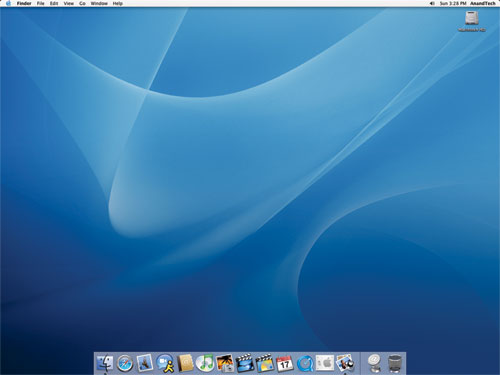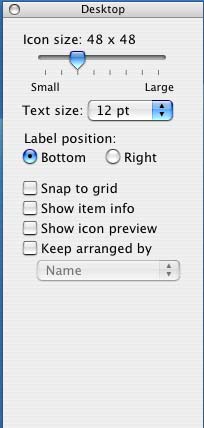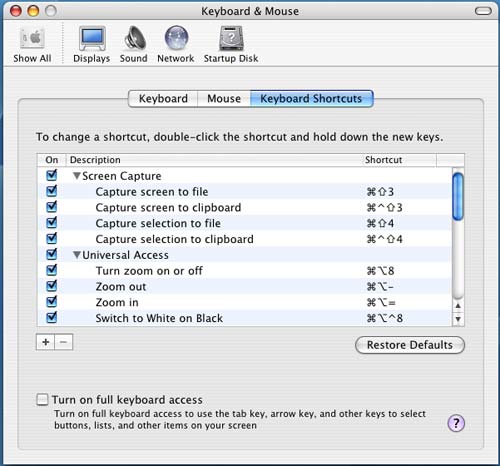A Month with a Mac: A Die-Hard PC User's Perspective
by Anand Lal Shimpi on October 8, 2004 12:05 AM EST- Posted in
- Mac
Finding my way around Finder
The OS X desktop is clearly different from what I was used to under XP. For starters, all of the icons have been moved to the right side of the screen; and where I was used to seeing a taskbar, there was this little translucent "dock" with a bunch of icons in it.
The OS X desktop and features, such as icon size, dock size and animations, are easily customizable.
Click to enlarge.
Under Windows, there is Explorer. It is the application that not only exists as a way of browsing your file system, but also as the "desktop" itself; the OS X equivalent? Finder. I don't think that I have to point out the similarity in the names. Yes, one company copied (or poked fun at) another.
My first reaction was that the icons on the desktop were far too large; indeed, they are, if you put them on a Windows desktop - but for some reason, they end up looking strange if you make them smaller. One of the biggest features of OS X is the ability to customize just about every aspect of the OS; I didn't like the size of the icons at first, so I simply changed the icon size through the "view options" menu. Although it's easy to talk about now, I had to ask how to do it online before I ever discovered the option - also the case with the majority of OS X, most of the power and customization of the OS remains hidden. I quickly realized that although Apple had targeted the entry level computer user with the interface of OS X, the OS was far more tailored to the power user in my opinion.

Where to start? Customization is much more possible (and easy to do) under OS X than any variant of Windows that I have ever encountered. Icon sizes are just the beginning; through the view options menu alone, you can change the positioning of the labels on the icons, the text size as well as the normal array of Windows options. And any changes you make here occur in real time - no clicking "OK" or "Apply". Just check a box and it happens instantaneously; and uncheck it, and everything goes back to normal. It's a small thing, but as I soon found out, much of OS X's appeal to me came in tiny gems like this.
The other thing to point out, which is quite possibly the biggest draw to OS X for me, is the fact that just about everything under OS X has a keyboard shortcut associated with it. I've found that if you got your start with PCs in the DOS days, then you end up being much more of a keyboard junkie than someone who is reliant on the mouse. I use the mouse when I have to, but when it's quicker to use the keyboard, I feel much more comfortable firing off a few keystroke combinations to get my point across. If you are anything like me in that respect, then OS X will be your playground.
I can't possibly list all of the keystroke combinations that I use on a daily basis, but there are quite a few. For example, I am a big "ALT-TAB"-er in Windows, but ALT-TAB is only really useful for switching applications, not closing them. The ALT-TAB equivalent under OS X, Command-TAB (the Command key is positioned where you'd expect ALT to be, so it works out fine), works similarly, but here's the catch - hit "Q" while you've selected an application and it will quit automatically. Nice, but nothing major right?
Want to minimize a window? Command-M will take care of that. Want to hide an application without minimizing it? Command-H. Hidden windows will automatically move to the end of the Command-TAB list, so you don't switch to them after you've hidden them.
Want to open a new Finder window? Command-N. Want to create a new folder on your drive? Shift-Command-N. I've always wanted to be able to create new folders in Explorer without using the mouse. OS X was a dream come true in that respect.
OS X will even let you define your own keyboard shortcuts for any application through the keyboard preferences panel:

Not impressed? Not a keyboard junkie? Then Finder is just as capable and as usable as Explorer. No big win for Apple there, but maybe a draw. For me, the little things are what intrigued me, but I'll admit - not everyone is as easily amused!
There is one aspect of the keyboard shortcut support that OS X does fall behind on, and that is support for keyboard shortcuts in dialog boxes. In some dialog boxes, hitting Command and the letter of the option you want to select will work, but in others, it will not. Furthermore, finding out the correct key to hit to select the option that you want is most definitely a guessing game, as there are no underlined characters or anything indicating what key to hit. Given OS X's strong support for keyboard shortcuts, this shortcoming (no pun intended) is puzzling.










215 Comments
View All Comments
vroem - Friday, October 8, 2004 - link
"Well, to install an application, you simply drag the application's installer to any folder on your hard drive and it's "installed". Doing so actually triggers a number of files to be copied to various places on your drive, but the fact that you are separated from that process, it really made me feel like I wasn't in control of my system."You are thinking to much!
The thing you copy to your disk is the application not an 'installer'. Nothing happens in the background.
For the windows users: in OS X an application is a "package". For the user it's a file, for the system it's a directory that contains everything to run like dylibs (mac-dlls).
The application package is not supposed to change. Settings are ONLY created in the right folder in 'Library' in the users home folder. Deleting the relevant settings file resets the program's settings to the defaults.
Kishkumen - Friday, October 8, 2004 - link
#34 - The phrase of the day is "price to performance" ratio. In fact #35 has some good information on the performance part of the equation. www.newegg.com has some good information for the price part of the equation. Look into it. A single Pentium 4 or Athlon 64 seems to perform quite well compared to dual 2.5 PPCs, but you're right, it's not about MHz. Perhaps I should say that Apple uses dual PPCs out of necessity due to IBM's inability to scale performance sufficientely per single PPC chip. In other words, if that's not clear enough, dual Xeon and Opterons are unnecessary for your typical x86 based workstation. Thus, better "price to performance" ratio. Now if you start beating us over the head again with this or that benchmark that the PPC "wins", again, don't forget the price part.Now, we have been going back and forth with the CPUs of the different platforms. We haven't even discussed video cards, hard drive performance/cost, cost of proprietary cables, etc. Say it again with me now, just so you don't forget what the argument is about..."price to performance".
cosmotic - Friday, October 8, 2004 - link
37: Moving windows on a Mac is much faster than windows since its all in the GPU. Did you mean resizing?38: I all those third party themes (and defualt windows theme) look like crap. They are all afterthoughts. And sorry I cant spell. And as for my feelings, using a G4 400 makes me feel better than using an athlonxp 2500+...
If your looking for a responsive UI, get BeOS. If your looking for smooth pretty UI, try MacOSX's tripple buffered glory.
Boonesmi - Friday, October 8, 2004 - link
ive used a couple g5's in the last several months. i wasnt disapointed with them at all. but if i had $3000 to waste on a new toy, no way would it be a new g5.my main rig is a dual opteron (less then half the cost of a new G5 to put it together) and when switching back and forth between the systems its clear to me that the dual opteron is superior (and not by a small margin)
granted the apps i run and the work i do arent the same as everyone else... im sure there are situations where a G5 would be better
darthlupin - Friday, October 8, 2004 - link
The one thing that has been missing from the article, and mostly glossed over in the comments is how Mac OS X is really a *nix with a great front end. If you install the "Developer Tools" (which comes with OS X on a separate CD and can also be downloaded), you then have access to GNU tools such as make and gcc, and Perl(though that may be native,) as well as XCode which has plenty of advanced features. That means that you now have access to almost every open source project out there. I guess Anand isn't into that kind of stuff, but any Linux user should appreciate it immediately.Once you really get to know it, and I don't mean getting to know Finder / Aqua, but the whole package, OS X really makes Windows look like a toy. (Without meaning any offence to the diehard Windows fans.) Talking about keyboard shortcuts on Mac OS X for 17 pages, (though I do appreciate them highly,) is like talking about the automatic coffe cup holder and reclining leather seats on your Abrams tank. I.e. that's not to say that they don't deserve mention, just that they don't scratch the surface of what you can do with it.
If you're a Linux person, it's a very short hop to switch to OS X, (a fully functioning X11 can be installed separately,) and the laptops aren't nearly as expensive, (though still much more expensive than the equivalent Dell.)
Micah - Friday, October 8, 2004 - link
I have found that upgrading and maintaining my girlfriend's Mac and getting things (especially hardware) working requires spending 1 of 2 things:1) Lots of $$! If you want a part, then Apple surely makes it. It will definitely look cool and work perfectly, but it will also cost 2-4x as much as the equivalent x86 part. Just look at Airport & Airport Extreme base-stations versus a Netgear or Linksys 802.11 wireless router.
2) Lots of time! In this way, the Mac seems to me a lot like Linux. I think a lot of 3rd party hardware out there works with Mac. Their towers come with PCI slots, for example. However, you still have to find the correct drivers or determine if the drivers are already built-in.
Just recently we went wireless in our apartment. I had to find a wireless PCI card based on a specific chipset for her Mac. Just like most Anandtech readers, I'm used to calling places and asking them to read product serial numbers to me to make sure that I get just the right model/revision/color/batch/stepping/whatever. However, that's usually a case of performance perfectionism. With the Mac, it was a case of getting the right chipset/revision/firmware or it just doesn't work, period. The only other time I've had to worry about that was with Linux.
So, I guess that my experiences with upgrading and maintaining the Mac have really soured me on it. Moreover, it has soured my girlfriend on them. She is really tired of having to do lots of research in order to find a non-Apple (read: affordable) piece of hardware that works with her Mac. She wants to be able to pick a box off the shelf at Best Buy and just be ready to go.
Mac promises ease-of-use, and it truly delivers...if you're willing to pay the big bucks.
offtangent - Friday, October 8, 2004 - link
Flamers ... bear in mind that he did buy this machine, so I dont see why he cant complain about it, if he chooses to.As for the barefeats article, demonstrating how the latest 2.5GHz dual-G5s beat the Opterons & Xeons that were released last year is hardly any feat!
L1FE - Friday, October 8, 2004 - link
For bob's sake people, it's not a benchmarking comparison but an editorial on his experience with the OS. And #33 how about you benchmark your "FEAL"ings on Mac since you obviously cared about that from your original complaint. And then you go on to say that it looks better than on a Windows machine when there are so many mods (win blinds) that look just as polished OSX. If I had an unlimited amount of cash, I'd buy a MAC. Until then I'll stick with my cheap PC and upgrade according to my needs. Nice editorial btw.P.S. It's FEEL. If you're going to emphasize it, at least spell it correctly.
CindyRodriguez - Friday, October 8, 2004 - link
as for sluggish interfaces and choppy windows resizes... my Athlon 3000+ OC'ed with a Radeon 9800Pro isn't smooth as silk when resizing windows. I think overall, the interface of Windows IS more responsive than OS X but I think boasting that windows takes a half or quarter second less to do something is worth squat at the end of the day.Now Fedora Core 2.. on my Athlon, that's how I want OS X to respond.. but i prefer microkernels over monolithic kernels from an architectural standpoint.. and X is dog slow for stuff like moveing windows.
Also, as for OS X's sluggishness, remember that it's a display PDF interface. You can print ANYTHING out to PDF. You get real alpha channels. You get WYSIWYG output on postscript printers. it may not be as snappy as other OSes but there is a lot of value that replaces those fractions of a second.
My one big (major) complaint about the Finder is that it is WAY too slow when you are browsing remote AFP directories (or other network volumes, but AFP stands out).. especially over slow links. I'd like to see the Finder recognize slow links and simply list the files/dirs.. and then maybe download custom icons in the background.
CU - Friday, October 8, 2004 - link
OS 9 did not support preemptive mult threading. I think that is what caused multi-tasking to be so slow on OS9. I have used OS9 and it is not something I won't to repeat. I use OSX at work and while it is way better than OX9, I still like XP better. The dock is nothing special. Win98 maybe even 95 I cannot remeber has the quick launch bar that can be put on every side of the screen. You can even have more than one. It will also auto hide. The dock did not impress me but it is so needed for OSX since it lacks any other way to get to application easily. Using Expose to get to your HD and then clicking through folders to get to the application you want to run is so Windows 3.1. The start menu in windows seems to be the best solution so far if you use lots of application. I have also noticed the scrolling issue in Safari that he mentioned. It is very bad on my Powerbook 1.25ghz 1gig of ram. I don't understand how you can have problems having lots of windows open in XP and not OSX. XP can group all like windows together in the taskbar and you can increase the size of the taskbar to have the screen if needed (not very usefull though). It also puts arrows on the side of it so you can view more windows that are open. In OSX the dock just starts getting way to small since that is where your App shortcuts are at also. The dock is already not large enough to hold all the shortcuts I need. Command-H doesn't always help because that hides the app and not just the current window. My Powerbook also crashes more than my PC at home but not by much. But I overclock everything in my PC and run games on it. Anyway it was good read.